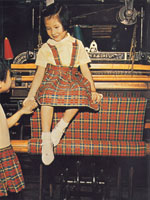| The development of the manufacturing
industries has been shaped by factors such as the
lack of natural resources, a relatively small domestic
market and a scare supply of industrial land.
As a result, Hong Kong's manufacturing industries
produce predominantly light consumer goods and operate
in multi-storey factory buildings. Hong Kong's
manufacturing has four salient characteristics: with
light manufacturing, especially textiles, as its mainstay;
taking outward processing trade as the basic route
of development; exhibiting high degree of internationalization;
and dominated maninly by Small and Medium-sized enterprises.
Clothing
The clothing industry has a
history of 60 years. It is the largest and the
most well-developed industry in Hong Kong. It
has been holding a leading position in the world since
the 1970's. Apart from being the world's second
largest clothing exporters, Hong Kong has become a
reputable garment sourcing centre in the Asia-Pacific
region, attracting orders ranging from mass produced
simple items to high fashion garments. Well
established manufacturers have stepped up marketing
efforts to promote their branded items and directly
market their products through their own overseas retail
outlets.
According to published statistics,
with a total of 3,007 establishments the clothing
industry employed 54,067 workers in 1999, which represented
23.8% of the total manufacturing workforce.
The sector is one of Hong Kong's major export earners,
accounting for 43.5% of total domestic exports in
1999 with an exporting amount of HK$ 74.25 billion. |
|
 Products of the Hong Kong garment industry
find a ready market in many parts of the world.

Modern factories
offering ideal conditions and the dexterity of garment
workers have been instrumental in enabling Hong Kong
goods to be put on world markets at competitive prices.
A conveyor
system in a workshop.

Hong Kong
Trade Development Council organises "Fashion Week"
every year to promote products of local fashion designers.
|



